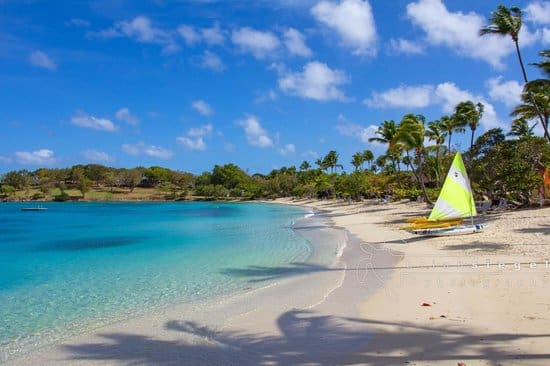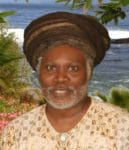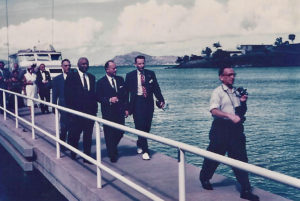
To this day, the Virgin Islands are still struggling from the aftermath of hurricanes Irma and Maria of September 2017. The island of St. John, a jewel of the Virgin Islands’ eco-tourism economy, was heavily impacted. The hurricanes destroyed the world-class, eco-friendly hotel known as Caneel Bay Resort.

Economically speaking, Caneel Bay Resort was the drawing card for St. John’s tourist industry besides the thousands of people that visited the National Park for its cultural, natural, historical, and marine resources. In other words, St. John is a place to escape into nature.
The brainchild behind the Caneel Bay development was the late conservation philanthropist Laurance S. Rockefeller. In 1952, Rockefeller visited St. John as he was sailing throughout the Caribbean on his yacht Dauntless, as part of his adventure, taking in the natural beauty of the West Indies archipelago. When he arrived at St. John, the island’s beauty took his breath away. However, the idea of setting land aside for a park on St. John for future generations first came up in 1939.
In 1939, a group of U.S. National Park Service professionals visited St. John to inspect the island and recommended to the local government to develop a new national park. This idea was stalled by World War II. It was not until the 1950s that the idea was revived again, to set aside land on St. John as a park. This time the players were the Rockefeller family.
Believe me, Laurance S. Rockefeller was ahead of his time when he came up with the idea to establish an eco-friendly resort on St. John. The idea came to him to restore Caneel Bay Sugar Plantation within a park-like setting. He later returned to St. John and purchased 600 acres at Caneel Bay from the Textron Corporation to build the resort. Despite skepticism by many of his critics about the economic feasibility of such a substantial investment, they were proven wrong over the years. Caneel Bay Resort became a world-class hotel and one of the most profitable hotels in the Caribbean region.
The end result was to create a “park system” that protected the tropical forest on St. John as well as the coastal marine environment, restored historic buildings, provided dive sites, created hiking trails, established underwater trails, and an eco-friendly hotel. While restoring the old Caneel Bay Sugar Plantation into a hotel, Rockefeller continued to acquire acres of land adjacent to the resort, which amounted to some 5,000 acres of a 12,500-acre island surrounded by the Caribbean Sea and Atlantic Ocean.

In December 1956, Caneel Bay hotel was opened. It was the same year Rockefeller transferred deeds for all property he had purchased outside of Caneel Bay to the National Park Service. When he handed over the deeds to then Director of the National Park Service Conrad Wirth, it came with great responsibility and stewardship of the land as stated in the mandate to the National Park Service, established by Congress in 1916.
The lands are entrusted for the people of these islands and visitors alike with the responsibility of the park to protect the natural, cultural, historical and marine resources. On that day of the transfer, where a new park was established on St. John, Rockefeller said these words: “It was seventeen years ago that Acting-Superintendent of Caribbean Areas, Harold Hubler, advanced the promising idea of an island park in this region of natural beauty … and now the vision of a park on St. John, ensuring the preservation of a portion of this magnificent island for the people of the Caribbean and visitors from elsewhere is a reality.”
It was Rockefeller’s intention that the park benefit local people of the Virgin Islands. For this reason, the population centers of the two towns, Cruz Bay and Coral Bay, were outside of the park boundaries. Caneel Bay Resort, which falls within the National Park boundaries with some 170 acres, will become part of the management of the National Park system when the lease expires on Sept. 30, 2023.
We should and must honor the wishes of Rockefeller, who wanted Caneel Bay properties to come under the control of the Secretary of the Interior and managed by the National Park Service, “for the use and enjoyment by visitors to the park of the outstanding scenic and other features of national significance located both within the premises and in other areas of the park.”
I support the National Park Service to carry out Rockefeller’s wishes.
Rockefeller wanted the Caneel Bay properties to become an integral part of the Virgin Islands National Park system. Caneel Bay shouldn’t only be enjoyed by visitors, but by all Virgin Islanders. I keep mentioning Virgin Islanders because it was native St. Johnians’ lands that helped create the park. Although there were issues relative to land acquisition from St. Johnians by the Jackson Hole Preserve Inc., which Rockefeller was president of, it is important to remember the sacrifices that were made by St. Johnians regarding their land becoming part of the national park.
The Rockefeller family felt that locals should have all access to the park. It is rightfully their land due to the colonial history of St. John. As a result, the lands were given as a gift back to the people of the Virgin Islands and managed by the National Park Service.
The properties have many natural and cultural features to the Virgin Islands, Caribbean and the world. There are some seven beaches with awesome natural beauty, intact coral reefs, underwater marine gardens, and a pre-Columbian site. The Danes and enslaved Africans occupied the Caneel Bay site since 1717. As Virgin Islanders, we should be supportive to the park to manage Caneel Bay for all people of the Virgin Islands.
Olasee Davis is an Extension Professor/Extension Specialist in Natural Resources at the University of the Virgin Islands who writes about the culture, history, ecology and environment of the Virgin Islands when he is not leading hiking tours of the wild places and spaces of St. Croix and beyond.





